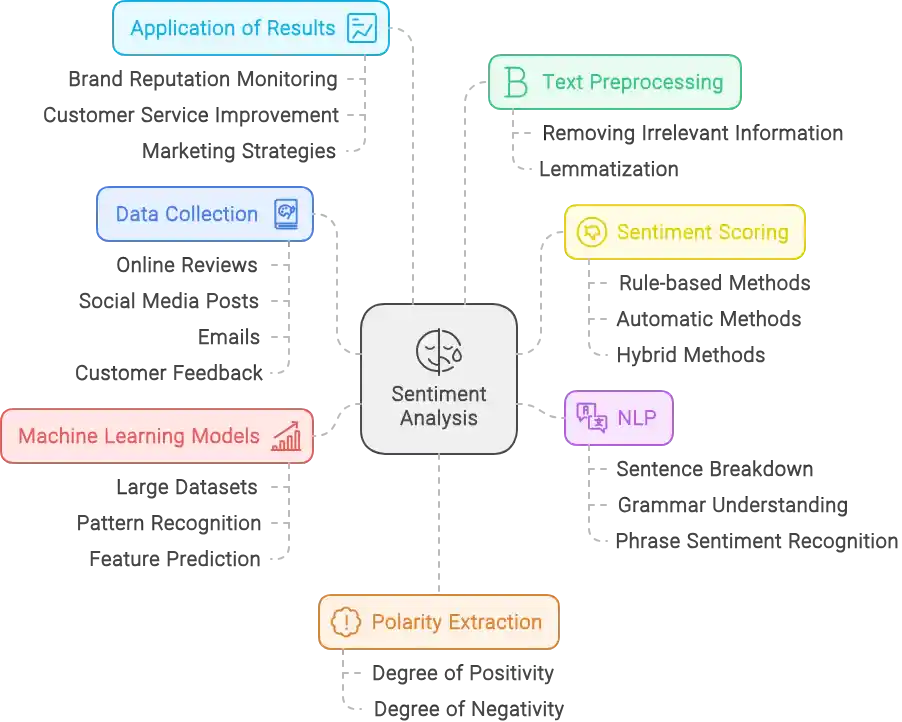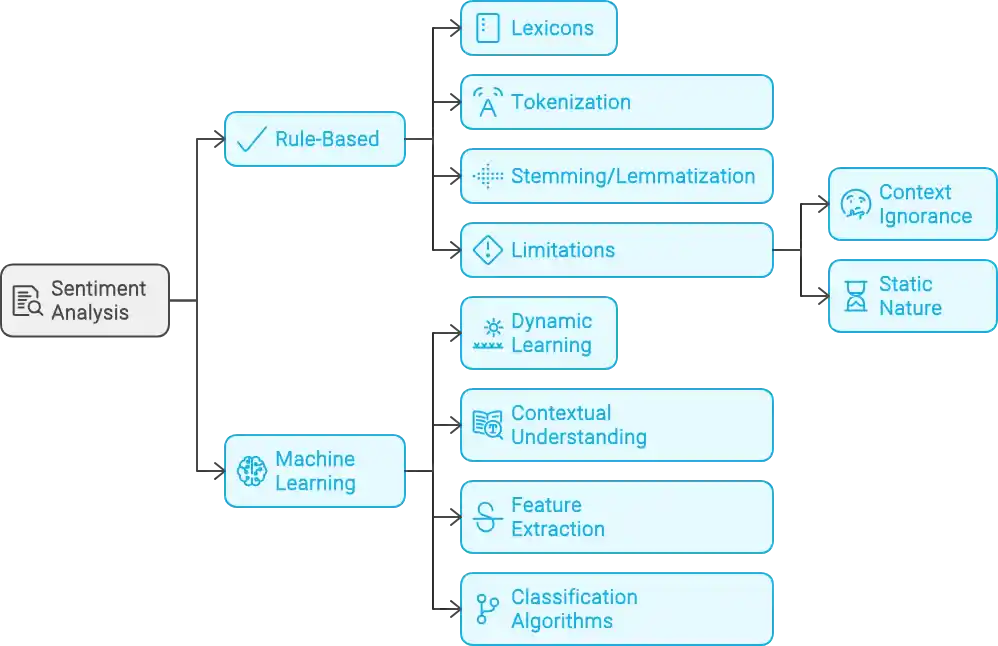Table of Contents
Understanding the Essence of Sentiment Analysis
Sentiment analysis is a critical method that helps one to understand public sentiment & impressions about certain products, brands, or topics.
An example would be to decide how a text expresses negative, positive, or neutral sentiments, it is also known as opinion deciding and sometimes emotional artificial intelligence. But, this analysis is an essential task for market research to assess brand monitoring and marketing campaign reviewing so that organizations can learn what their customers think of them, and how they feel while overserving you.
They utilize methods like natural language processing (NLP) and machine learning to access vast amounts of data from various sources such as social media posts or product reviews, delivering valuable insights for decision-making. Finally, it is the strength of sentiment analysis that directly or indirectly helps in making your customers satisfied and protects your brand reputation.
What is Sentiment Analysis? Defining the Concept
It is a process, that makes use of data mining and machine learning techniques as well the natural language processing to convert this raw unstructured text into features that are from trade-off among known sentiment analysis training. At its core, here are some defining elements of the idea :
- Objective: The main objective of sentiment analysis is to classify the text into one, two, or more prescribed categories like positive view vs negative view. It helps organizations understand what their customers think of them as well as how they view and experience the products or brands.
- Use Cases: Companies use sentiment analysis to track brand awareness, reputation, and visibility trends over time. It is useful for investigating how customers are receiving a new product or functionality, potentially informing future enhancements to the product.
- Sources: Sentiment analysis systems can be trained using feedback gleaned from online platforms such as social media posts, product review emails, or customer service tickets. The use of a range of data sources allows the company to have an end-to-end view of customer sentiment in near real-time.
- Skills: The evaluation makes use of algorithms that can be rule-based, computerized, or hybrid to attain the sentiment being expressed inside the text. They also automatically obtain the polarity of sentiments, and find out subject-proposing/opinion-supporting pairs among different sentences.
- Key Benefit: sentiment analysis allows companies to act on customer feedback so that they can not only maintain but also increase the level of satisfaction at a brand level.
The Importance of Sentiment Analysis in Today’s Digital World

In the digital era, where customer opinions and feedback are publicized on different platforms, sentiment analysis has become more crucial. Given how important it is, I want to call out a couple of the reasons:
- Insight into Customer Perception: Sentiment analysis enables organizations to measure how customers respond to their products and brands. Digital sentiment analysis — by examining the sentiments in online reviews, social media, and other digital communication, we understand more and better about consumer experiences.
- Live Feedback: With sentiment analysis, firms can follow live customer feedback in this fast digital era. Organizations benefit from this ability to respond quickly and support customer issues, increasing satisfaction and loyalty.
- Increasing Customer Satisfaction and Sales: It allows organizations to analyze customer sentiments to improve their products or services. This proactive step goes a long way in effective product development, resulting in low customer churn.
- Brand Reputation: Sentiment analysis is an essential part of brand reputation where the sentiment regarding a brand can change feel free samplingqi over time. It lets businesses know how the brand is currently perceived in the market and helps them to take before any negative statements get out of control.
- Automating Customer Service—Sentiment analysis tools can also categorize customer service requests and send automated replies based on the sentiment that has been detected. This system goes on to enhance efficiency which in turn guarantees customers are offered assistance promptly.
- Providing Insights on the Market: Sentiment analysis can provide insights for companies about the new marketing trends and what strategy is getting more clicks. Which is valuable intelligence when shaping marketing campaigns and launching products.
- Integration with Other Tools: Sentiment analysis tools also come in the form of APIs, which businesses can use to dig into feedback from customers more effectively. Such integration allows organizations to check which issues customers are facing and accordingly change their strategies.
How Sentiment Analysis Works: A Peek Under the Hood

Sentiment analysis is a sophisticated process that involves several steps and techniques to determine the emotional tone behind a body of text. This is an explanation of how it functions:
- Data Collection: The first step in sentiment analysis is gathering data from various sources. This can include online reviews, social media posts, emails, and customer feedback. The goal is to collect a diverse set of texts that reflect customer opinions and sentiments, using integrations like Gmail to Google Sheets and other automated methods to efficiently centralize data.
- Text Preprocessing: Once the data is collected, it undergoes preprocessing. This involves cleaning the text by removing irrelevant information, such as punctuation and stop words (common words that add little meaning). Techniques like lemmatization are used to convert words into their root forms, which helps in standardizing the text for analysis.
- Sentiment Scoring: After preprocessing, the text is analyzed using various algorithms. These algorithms can be rule-based, automatic, or hybrid methods. They assign sentiment scores to the text, categorizing it as positive, negative, or neutral. This scoring is crucial for understanding the overall sentiment expressed in the text.
- Natural Language Processing (NLP): A lot of sentiment analysis uses NLP techniques. NLP helps in understanding the context and nuances of language, allowing the system to interpret sentiments more accurately. It involves breaking down sentences, understanding grammar, and recognizing the sentiment behind phrases.
- Machine Learning Models: Many sentiment analysis systems utilize machine learning models to improve accuracy. These models are trained on large datasets to recognize patterns in text and predict sentiments based on learned features. The more data the model is trained on, the better it becomes at accurately classifying sentiments.
- Polarity Extraction: In addition to scoring, sentiment analysis can extract polarity, which indicates the degree of positivity or negativity in the text. This can be useful for understanding not just whether a sentiment is positive or negative, but how strong that sentiment is.
- Application of Results: Finally, the results of sentiment analysis are applied in various ways. Organizations use these insights to monitor brand reputation, improve customer service, and inform marketing strategies. By understanding customer sentiments, businesses can make data-driven decisions that enhance customer satisfaction and loyalty.
The Role of Natural Language Processing in Sentiment Analysis
Natural Language Processing (NLP) plays a crucial role in sentiment analysis, enabling machines to understand and interpret human language. Here’s how NLP contributes to this process:
- Understanding Context: NLP helps in grasping the context of words and phrases within a sentence. This is important because the same word can have different meanings depending on how it is used. For example, “great” can be positive in one context and sarcastic in another. NLP techniques help in identifying these nuances, which is essential for accurate sentiment classification.
- Text Preprocessing: Before analyzing sentiment, NLP is used to preprocess the text. This includes cleaning the data by removing unnecessary elements like punctuation and stop words. It also involves techniques like stemming and lemmatization, which reduce words to their base forms. This standardization helps in making the analysis more effective and accurate.
- Feature Extraction: NLP algorithms automatically extract features from the text that are relevant for sentiment analysis. This can include identifying keywords, phrases, and even the structure of sentences. By focusing on these features, NLP helps in determining whether the sentiment expressed is positive, negative, or neutral.
- Sentiment Scoring: NLP techniques are used to assign sentiment scores to the text. These scores indicate the overall sentiment of the text, allowing for a clear classification. For instance, a review might be positive if it contains many positive words and phrases, while a negative score would indicate the opposite.
- Machine Learning Integration: NLP works with machine learning models in sentiment analysis. Large datasets are used to train these models to identify linguistic trends. The combination of NLP and machine learning allows for more sophisticated analysis, as the models learn to identify sentiments based on the features extracted by NLP.
- Improving Accuracy: By utilizing advanced NLP techniques, sentiment analysis systems can improve their accuracy. For example, deep learning methods can analyze word associations and context more effectively, leading to better sentiment classification. This is particularly useful in understanding complex sentiments expressed in social media or customer feedback.
Machine Learning Techniques for Effective Sentiment Analysis
Machine learning techniques play a crucial role in enhancing the effectiveness of sentiment analysis by enabling the classification of text into various sentiment categories, such as positive, negative, or neutral. Here are some key techniques used in this field:
- Supervised Learning: This approach involves training algorithms on labeled datasets, where each text sample is associated with a sentiment label. The model learns to identify patterns that correlate with different sentiments, improving its predictive accuracy over time.
- Natural Language Processing (NLP): NLP techniques are employed to process and analyze human language, allowing machines to understand and interpret text data. This is essential for extracting sentiment from various sources, including social media, reviews, and customer feedback.
- Word Embeddings: Techniques like word2vec represent words as vectors in a high-dimensional space, capturing semantic relationships between words. This allows the model to understand the context and improve sentiment classification by grouping similar words.
- Deep Learning: Recent advancements in deep learning have introduced neural network models that can learn complex patterns in large datasets. These models can automatically extract features from text, leading to more accurate sentiment analysis.
- Text Analytics: Sentiment analysis systems collect data on customer sentiment and brand reputation through text analytics. By analyzing various online sources, these systems can provide real-time feedback on public perception.
- Polarity Detection: Algorithms are designed to assess the polarity of text, determining the degree of positivity or negativity expressed. This can be applied to different text segments, such as sentences or paragraphs, enhancing the granularity of sentiment analysis.
Types of Sentiment Analysis: Rule-Based vs. Machine Learning Approaches

Sentiment analysis is a crucial aspect of natural language processing (NLP) that helps in determining the emotional tone behind a series of words. There are two primary approaches to sentiment analysis: rule-based and machine learning (ML) approaches. Here’s a detailed comparison of both:
Rule-Based Sentiment Analysis
- Definition: This traditional method relies on a set of manually created rules to analyze text. It uses predefined lexicons, which are lists of words associated with positive or negative sentiments.
- Techniques Used: Rule-based sentiment analysis employs various NLP techniques, including:
- Lexicons: Lists of words categorized by sentiment.
- Tokenization: dividing a text into words or sentences.
- Stemming and Lemmatization: Reducing words to their root forms to ensure consistency in analysis.
- Limitations:
- Context Ignorance: Rule-based systems often fail to consider the context of words, leading to potential misinterpretations. For example, they might not accurately analyze phrases with negations, such as “not good”.
- Static Nature: These systems require constant updates to their lexicons and rules to remain effective, which can be resource-intensive.
Machine Learning Sentiment Analysis
- Definition: This approach utilizes machine learning algorithms to analyze text data. It learns from training data to predict sentiment in new, unseen text.
- Advantages:
- Dynamic Learning: ML models can adapt and improve over time as they are exposed to more data, making them more flexible than rule-based systems.
- Contextual Understanding: Machine learning models can consider the entire sentence or document, allowing for a more nuanced understanding of sentiment.
- Techniques Used: ML sentiment analysis often involves:
- Feature Extraction: Identifying relevant features from the text that contribute to sentiment.
- Classification Algorithms: Using algorithms like support vector machines, neural networks, or decision trees to classify text as positive, negative, or neutral.
Preparing Your Data: The First Step in Sentiment Analysis
Preparing your data is a crucial first step in sentiment analysis, as it sets the foundation for accurate and effective analysis. This process typically involves several key tasks, including data collection, cleaning, and transformation. Initially, you need to gather relevant text data from various sources, such as social media posts, product reviews, or customer feedback.
Once the data is collected, it must be cleaned to remove any irrelevant information, such as HTML tags, special characters, or stopwords that do not contribute to sentiment.
Following this, the text transforms techniques like tokenization, lemmatization, and vectorization, which convert the text into a numerical format that machine learning models can understand. This preparation phase is essential because the quality of the input data directly impacts the performance of the sentiment analysis model, ensuring that it can accurately classify sentiments as positive, negative, or neutral.
Text Preprocessing: Cleaning and Formatting Your Data
Text preprocessing is a vital step in preparing your data for sentiment analysis, as it involves cleaning and formatting the text to ensure that it can be effectively analyzed by machine learning algorithms. This process begins with the removal of irrelevant details, such as special characters, HTML tags, and stopwords, which do not contribute to the sentiment being analyzed.
Following this, the text is formatted through various techniques, including tokenization, which breaks the text into individual words or phrases, and lemmatization, which reduces words to their base or root form.
These steps help in standardizing the text, making it easier for algorithms to interpret the underlying sentiment. Additionally, incorporating idioms and emojis into the training data can enhance the model’s understanding, as these elements often carry significant emotional weight in user-generated content.
Overall, effective text preprocessing not only improves the accuracy of sentiment analysis but also ensures that the data is in a machine-readable format, allowing for a more insightful analysis of customer opinions and sentiments.
Choosing the Right Tools and Libraries for Sentiment Analysis
Selecting the appropriate tools and libraries for sentiment analysis is crucial for achieving accurate and efficient results. The following are some important things to remember:
- Purpose and Requirements: Identify the specific goals of your sentiment analysis project. Different tools cater to various needs, such as real-time analysis, batch processing, or integration with other systems. Knowing what you need will make it easier to reduce the number of possibilities.
- Machine Learning vs. Rule-Based Approaches: Depending on your expertise and the complexity of the task, you may choose between machine learning (ML) libraries or rule-based systems. ML libraries like TensorFlow and Scikit-learn offer robust frameworks for building custom models, while rule-based systems can be simpler to implement for straightforward tasks.
- Natural Language Processing (NLP) Libraries: Libraries such as NLTK, SpaCy, and TextBlob provide essential tools for text preprocessing, including tokenization, stemming, and lemmatization. These preprocessing steps are vital for preparing your data for sentiment analysis.
- Integration Capabilities: Ensure that the tools you choose can easily integrate with your existing systems, such as customer support software or data analytics platforms. This integration allows for seamless data flow and enhances the overall efficiency of your sentiment analysis efforts.
- Community and Support: Opt for tools and libraries that have a strong community and support system. This can be beneficial for troubleshooting issues, accessing tutorials, and sharing knowledge with other users.
- Performance and Scalability: Consider the performance of the tools, especially if you are dealing with large datasets. Some libraries are optimized for speed and can handle big data more efficiently than others.
By carefully evaluating these factors, you can choose the right tools and libraries that align with your project goals and technical capabilities, ultimately leading to more effective sentiment analysis outcomes.
Building Your Sentiment Analysis Model: A Step-by-Step Approach
Creating a sentiment analysis model involves several key steps that ensure the model is effective and accurate. Here is a thorough how-to to assist you with the procedure:
Step 1: Define Your Objective:
Clearly outline what you want to achieve with your sentiment analysis. Are you looking to analyze customer feedback, social media posts, or product reviews? Understanding your objective will guide your model’s design and the data you need to collect.
Step 2: Data Collection
Gather a dataset that is relevant to your objective. This could include text from emails, blog posts, tweets, or customer reviews. Ensure that your dataset is diverse and representative of the sentiments you wish to analyze. Tools like web scraping or APIs can be useful for collecting this data.
Step 3: Data Preprocessing
Prepare your text data for analysis. This involves several tasks:
- Tokenization: Dividing a text into separate words or sentences.
- Lemmatization and Stemming: reducing a term to its root or fundamental form.
- Stopword Removal: Eliminating common words that do not contribute to sentiment (e.g., “and”, “the”).
These preprocessing steps help in cleaning the data and making it suitable for analysis.
Step 4: Feature Extraction
Transform your textual input into a numerical format that can be interpreted by machine learning models. This can be done through methods like:
- Bag of Words: Counting the frequency of words in the text.
- Vectorization: Transforming text into numerical vectors using techniques like TF-IDF (Term Frequency-Inverse Document Frequency).
Step 5: Model Selection
Select a machine learning model based on your requirements. Common models for sentiment analysis include logistic regression, support vector machines, and neural networks. You may also consider using pre-trained models or libraries that simplify the process, such as TensorFlow or Scikit-learn.
Step 6: Model Training
Train your selected model using the prepared dataset. This involves feeding the model with the training data and allowing it to learn the patterns associated with different sentiments. Ensure to split your data into training and testing sets to evaluate the model’s performance accurately.
Step 7: Model Evaluation
After training, assess the model’s accuracy using metrics such as precision, recall, and F1-score. This evaluation helps determine how well the model performs on unseen data.
Step 8: Deployment and Monitoring
Once you’re satisfied with the model’s functionality, deploy it in a real application. Continuously monitor its performance and update the model as necessary to adapt to new data or changing sentiments.
By following these steps, you can build a robust sentiment analysis model that effectively captures and analyzes sentiments in text data.
Evaluating Your Model: Metrics and Techniques for Success

Evaluating the performance of your sentiment analysis model is crucial to ensure its effectiveness. Here are key metrics and techniques to consider:
Accuracy
This metric measures the proportion of correct predictions made by the model compared to the total predictions. While it provides a general sense of performance, it may not be sufficient for imbalanced datasets where one sentiment class is more prevalent than others.
Precision
Precision indicates the number of true positive predictions divided by the total number of positive predictions (true positives + false positives). It helps assess how many of the predicted positive sentiments were correct. When false positives come at a significant cost, accuracy is crucial.
Recall (Sensitivity)
Recall measures the number of true positive predictions divided by the total actual positives (true positives + false negatives). It illustrates how well the model was able to locate all pertinent examples. High recall is crucial when missing a positive sentiment could have significant consequences.
F1-Score
The harmonic mean of recall and precision yields the F1-score, which strikes a compromise between the two. It is particularly useful when you need a single metric to evaluate the model’s performance, especially in cases of class imbalance.
Confusion Matrix
A confusion matrix provides a detailed breakdown of the model’s predictions, showing true positives, true negatives, false positives, and false negatives. This visualization helps identify specific areas where the model may be underperforming.
ROC-AUC Score
Plotting the true positive rate versus the false positive rate at different threshold levels is known as the Receiver Operating Characteristic (ROC) curve. AUC, or Area Under the Curve, measures the model’s overall capacity for class discrimination. Greater model performance is indicated by a higher AUC.
Cross-Validation
Implementing cross-validation techniques, such as k-fold cross-validation, helps ensure that the model’s performance is consistent across different subsets of the data. This technique reduces the risk of overfitting and provides a more reliable estimate of model performance.
Error Analysis
Conducting a thorough error analysis involves reviewing the instances where the model made incorrect predictions. Understanding the reasons behind these errors can provide insights into potential improvements, such as refining the training data or adjusting model parameters.
Challenges in Sentiment Analysis: Common Pitfalls and How to Avoid Them

Sentiment analysis is a complex task that comes with several challenges. The following are some typical dangers and ways to stay clear of them:
Human Annotator Accuracy
One of the significant challenges in sentiment analysis is the limitations of human annotator accuracy. Even trained annotators can struggle to identify sentiment correctly, leading to inconsistencies in the training data. This can be measured using inter-annotator agreement, which assesses how well different annotators make the same decisions. To mitigate this, it is essential to provide clear guidelines and training for annotators to improve consistency and accuracy.
Complexity of Human Language
The intricacies of human language, including sarcasm, negation, and metaphors, can lead to misinterpretation by sentiment analysis models. Rule-based systems, in particular, may miss these nuances as they often do not consider the context of the entire sentence. To address this, consider using machine learning models that can learn from context and adapt to various linguistic patterns.
Data Quality and Bias
The quality of the training data significantly impacts the performance of sentiment analysis models. If the data is biased or unrepresentative, the model may produce skewed results. Regularly reviewing and updating the training dataset can help ensure that it reflects diverse sentiments and contexts. Additionally, employing techniques to detect and mitigate bias in the data can enhance model performance.
Choosing the Right Approach
With numerous sentiment analysis solutions available, selecting the appropriate method for your specific needs can be challenging. It’s crucial to evaluate different approaches, such as rule-based, machine learning, or hybrid methods, to determine which best suits your objectives. Conducting thorough research and testing various models can help in making an informed decision.
Overfitting
When a model learns the training set too thoroughly—including the noise and outliers—it is said to be overfitting, which results in poor generalization of new data. To avoid overfitting, use techniques such as cross-validation, regularization, and keeping the model architecture simple. This ensures that the model captures the underlying patterns without becoming too tailored to the training set.
Future Trends in Sentiment Analysis: What Lies Ahead

Sentiment analysis is an evolving field that is likely to see several exciting trends in the coming years. Here are some anticipated developments:
Integration of Deep Learning
The use of deep learning and artificial neural networks has already transformed natural language processing (NLP) and is expected to continue doing so in sentiment analysis. These advanced techniques can better capture the complexities of human language, including context and sentiment nuances, leading to more accurate results. As models become more sophisticated, they will likely improve the understanding of sentiment in various contexts, such as social media and customer feedback.
Real-time Sentiment Analysis
Organizations are increasingly seeking real-time insights into customer sentiment to make timely decisions. Future sentiment analysis tools will likely focus on processing large volumes of data quickly, allowing businesses to respond to customer feedback and market trends almost instantaneously. This capability will enhance brand reputation management and customer engagement strategies.
Multimodal Sentiment Analysis
As sentiment analysis expands, there will be a growing emphasis on multimodal approaches that analyze not just text but also images, videos, and audio. This trend will enable a more comprehensive understanding of sentiment by considering various forms of expression. For instance, analyzing video content alongside comments can provide deeper insights into public sentiment regarding a brand or product.
Personalization and Contextualization
Future sentiment analysis systems will likely incorporate personalization and contextualization features. By understanding individual user preferences and historical interactions, these systems can provide tailored insights that reflect specific customer sentiments. This trend will enhance marketing strategies and customer relationship management by allowing businesses to cater to individual needs more effectively.
Ethical Considerations and Bias Mitigation
As sentiment analysis becomes more prevalent, there will be an increased focus on ethical considerations, particularly regarding data privacy and bias. Future developments will likely include more robust frameworks for ensuring that sentiment analysis tools are fair and unbiased. This will involve ongoing efforts to identify and mitigate biases in training data and algorithms, ensuring that the insights generated are equitable and representative of diverse populations.
Conclusion
In conclusion, sentiment analysis is a powerful tool that leverages data mining, machine learning, and natural language processing to extract insights from text. It plays a crucial role in helping organizations understand customer sentiment, improve brand reputation, and enhance customer experience. Here are some key takeaways:
Understanding Sentiment
Sentiment analysis helps identify whether a piece of text expresses positive, negative, or neutral feelings. This capability is essential for businesses looking to gauge customer opinions and sentiments effectively.
Applications Across Industries
The applications of sentiment analysis are vast, ranging from brand monitoring to market research and human resources. Companies can utilize these insights to become more competitive and better understand their customers’ needs and preferences.
Thematic Analysis Integration
Combining thematic analysis with sentiment analysis allows organizations to identify key themes in customer feedback. For instance, in a case study involving Atom Bank, themes like “ease of use” were associated with positive sentiment, while issues like “authentication” were linked to negative sentiment. This integration helps prioritize improvements that matter most to customers.
Real-World Impact
The practical implications of sentiment analysis are evident in the success stories of companies like Atom Bank, which improved its app features based on customer sentiment insights. This led to higher ratings and reduced customer service demands, showcasing the tangible benefits of effectively utilizing sentiment analysis.
Future Directions
As sentiment analysis continues to evolve, future trends will likely include advancements in deep learning, real-time analysis, and ethical considerations. These developments will enhance the accuracy and applicability of sentiment analysis across various sectors, making it an indispensable tool for businesses in the digital age.
In summary, sentiment analysis is not just a trend but a vital component of modern business strategy, enabling organizations to connect with their customers on a deeper level and drive meaningful improvements.